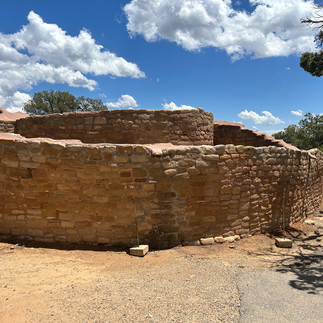Examining Interpretative Practices at America's National and State Parks: Part One
- Kelan Amme

- Aug 18, 2024
- 6 min read
Updated: Aug 19, 2024

To draw thousands of visitors annually, National and State Parks, Historic Sites, and Monuments rely on clever marketing and scenic accommodations that promise to educate and inspire in some way, shape, or form. Whether managed by the National Parks Service, Forest Service, or a state-based wildlife/conservation department, one essential aspect of interpretation is how the public views and interacts with the site's history, memory, and geographic features.
Following our college graduation, I had the opportunity to travel across the United States with five of my friends for just under a month. From Indiana to Wyoming, Colorado to Arizona, and New Mexico to Tennessee, we visited over twenty unique National and State Parks, historic sites, monuments, and museums, observing landscapes and stories that took our breath away. This was my first time traveling out West in many years, and also my first time visiting Colorado, Utah, Arizona, New Mexico, Texas, Oklahoma, and Arkansas. Naturally, as an amateur photographer and aspiring archivist/public historian, I always had my camera in hand as I documented each state we passed through, noting any historical interpretation at public sites nationwide.
Considering the number of locations we visited, I would like to focus this article on a few sites I felt were unique in how they interpreted their story and history, creating new avenues for learning even through outdoor adventure, visitor centers, and public exhibits. I will also compare and comment on the sites' successes and potential shortcomings where applicable.
With Yellowstone National Park becoming the first park to be founded in 1872, the United States, still limping from the downfall of Reconstruction following the Civil War, had little support for an established natural preservation movement across the country on an organizational level. The interest in exploring the outdoors remained, even with the 1916 creation of the National Park Service. However, it "... was partially the result of a lack of coordinated policy and leadership in financing and administering the parks that already existed." Thanks in part to the leadership of the first Superintendent of Parks, Stephen Tyng Mather, a steady stream of support, both legislative and public, allowed for the continued establishment and evolution of heritage sites to achieve National Park Status (1).
Naturally, the opportunities for interpretation at public heritage, nature, and cultural sites are widely dependent on the size of the site, funding allocated, and its "significance" determined by scholars and the public perception; it ultimately relies on a creative team to organize and amplify their site's voice.
In this article, you will visit:
Mesa Verde National Park (Colorado)
Chimney Rock National Monument (Colorado)
Custer State Park (South Dakota)
Grand Teton National Park (Wyoming)
Arches National Park (Utah)
Little Rock Central High School National Historic Site (Arkansas)
All sources are footnoted and listed at the end of the article. Also, please explore the hyperlinks located throughout the article.
Mesa Verde National Park, Monctezuma County, Colorado
In 1906, President Theodore Roosevelt created Mesa Verde National Park in southwestern Colorado to honor the site's cultural, historical, and natural history. Mainly known for the cliff dwellings created by the Ancestral Pueblo peoples over 1400 years ago, the park covers 81 square miles of rock formations, canyons, and lush green shrubbery.
The Mesa Verde Visitor Center is located immediately at the park entrance due to the altitude and natural formations that make traversing other park areas difficult by vehicle. Planted in the opening walkway is an impressive sculpture created by Edward J. Fraughton entitled "The Ancient Ones," which depicts an Ancestral Puebloan climbing up a cliffside wearing a pack containing some natural resources, possibly plant stalks. The sculpture sits on top of a stone pedestle and was sculpted in such a way that takes the viewer into a setting where they may look up and only be about 6-8 feet below the Puebloan man, who is depicted anatomically realistic. His bare feet and hands cling to the side of a skinny cliff, an almost tree-shaped structure, while his head is tilted downwards, either glancing at the unknown height of his climb or hiding from the constant sunlight that inhabits the Four Corners Region.
(1): Mesa Verde Visitor Center - Image by The National Park Service
(2): Mesa Verde Visitor Center entrance sign - Kelan Amme
(3): Photo of The Ancient Ones - Kelan Amme
(4): Photo of The Ancient Ones - Kelan Amme
Besides the visitor center exterior being architecturally unique, at least from my perspective, it was the interior exhibits that I was most interested in. Multiple inset windows and cases were located to the left of the main entrance, allowing visitors to explore the unique archaeological pieces discovered at Mesa Verde. This was the first time I had seen such an extensive archive of cultural heritage material in a National Park visitor center. Understanding that Mesa Verde also offers this structure as a place for researchers, I commend their ability to allow such transparency between their dedicated team of interpreters and Cultural Heritage specialists, even providing visitors with touch-screen devices to view significant artifacts in their collection. Also located in the lobby were multiple windows to view workers examining pieces that were bagged, cleaned, and ready to be cataloged.
Mesa Verde Artifact Collection - Kelan Amme
Throughout the lobby, various exhibitions depicted ancestral Puebloans scaling rock faces, practicing agricultural practices, and performing tasks necessary to live in such a unique and seemingly unforgiving environment. Also included are models of archaeologists and surveyors exploring the remains of a Puebloan structure. A unique topographic model of the park allows users to highlight specific areas via a connective system of lights. While simple, the button-pressing, light-activating still provided my friends and me small bursts of enjoyment as specific locations or geographic features lit up. All the while, large floor-to-ceiling windows offer views of the broad and surrounding mountain ranges. The u-shaped store and exhibit wing does not necessarily take visitors on one specific track but allows for exploring certain exhibits that cater more toward younger audiences than older ones and vice versa. For a full tour, I recommend checking out this video of the visitor center by JSA Adventures on YouTube.

Mesa Verde Exhibit Wing - Wikimedia Commons
What allows Mesa Verde to stand out in the area of interpretation is its ability to serve as an educational entity that tells the story of the ancestral Puebloan peoples. It accomplishes this through its continued relationship with surrounding Native American cultural heritage sites such as Chimney Rock, further bridging the stories of those who lived on this land over 1400 years ago. Because the interest in a National site is dependent on the historical and cultural significance of what kind of story is being told (in addition to the natural landmarks), National Parks have often looked to appeal to the "average American" according to the architectural and urban history scholar Daniel E. Coslett and urban planner Manish Chalana. Writing in The Public Historian, Coslett and Chalana outline that, historically, parks have looked to use "original objects" and "illustrative media" as a form of education, focusing on the ways visitors may form their "own understanding and feeling." While this is an understandable goal for all public history sites, Coslett and Chalana argue that...
"... the degree to which sites’ complexity is meaningfully engaged remains debatable. The act of justifying a park’s raison d’eˆtre, which can sometimes overemphasize its
significance, necessitates constant reaffirmation to sustain legitimacy, either through
the repetition of existing programs and narratives or by creating new ones (2)."
Mesa Verde National Park has succeeded in sustaining its legitimacy through engaging exhibitions, public programming, hands-on exploration, and research opportunities. By allowing viewers to examine and interact with artifacts as soon as they enter the park, the interest in learning where objects came from is heightened when presented with avenues to travel through locations like the Cliff Palace on foot (via a reservation system, of course). Similar to how exhibitions are designed to take viewers around a space, park infrastructure can be diverse, creating one's adventure routes into how much one may want to learn on their visit. The cultural resources of parks like Mesa Verde work in tandem with the natural history of the site and, as the historian Page Putnam Miller writes, "[w]ithout knowledge of the history of the subject and an accurate sense of the past, the interpretive program has little depth or integrity... Today there seems to be a renewed awareness of the need to intertwine research and interpretation... (3)."
Mesa Verde is a beautiful park, as many are, and I encourage anyone reading to visit if they are ever traveling through Colorado. This article will be the beginning of a recurring series I hope to publish on this blog, so please be on the lookout for more articles discussing interpretation at the sites listed above. Thank you for your time!
Additional structures located in Mesa Verde National Park - Kelan Amme
Kelan Amme is a graduate student pursuing a Master of Information (Science), concentrating in Archives and Preservation at Rutgers University in New Brunswick, New Jersey.
Footnotes:
"Brief History of the National Parks," Library of Congress Mapping the National Parks Collection, accessed August 18, 2024, https://www.loc.gov/collections/national-parks-maps/articles-and-essays/brief-history-of-the-national-parks/.
Daniel E. Coslett and Manish Chalana, "National Parks for New Audiences: Diversifying Interpretation for Enhanced Community Relevance," The Public Historian 38, no. 4 (November 2016): 104, JSTOR, https://www.jstor.org/stable/26420935.
Page Putnam Miller, "Reflections on Historical Advocacy and the National Park Service," The Public Historian 9, no. 2 (Spring 1987): 107, JSTOR, https://www.jstor.org/stable/3377333.










































Comments